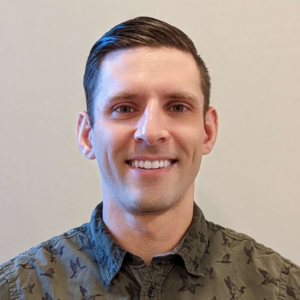La Salle University
Jeffrey Brown, Ph.D.

The primary goal of Dr. Brown’s research is to increase the well-being of both wildlife and people through urban ecological conservation and the incorporation of ecological infrastructure into urban design. Dr. Brown’s research focuses on three central questions:
1. How does wildlife use urban ecological infrastructure and what are the implications for conservation?
2. How do people, through both indirect and direct interactions, shape wildlife distribution and how do people’s behaviors and values relate to their actions toward wildlife?
3. How can community collected data better increase understanding of human0wildlife interactions?
To answer these questions, Dr. Brown combines both computational models, field experiments, social surveys, and the use of community collected and publicly available datasets.
Before coming to La Salle, Dr. Brown was a postdoctoral research associate and lecturer at Arizona State University (ASU). At ASU, Dr. Brown worked with the Central Arizona-Phoenix Long-Term Ecological Research Project (CAPLTER) studying human-wildlife interactions. Dr. Brown is currently senior personnel at CAPLTER and the assistant-director of the Phoenix Area Social Survey. Dr. Brown received his Ph.D. in from Dr. Julie L. Lockwood at Rutgers University. At Rutgers, his dissertation focused on ecological community dynamics in urban forest fragments. Prior to attending Rutgers, Dr. Brown received his B.S. in ecology and evolutionary biology from Rice University where he worked with Dr. Haldre Rogers and the Ecology of Bird Loss Project.
In addition to his research interests, Dr. Brown enjoys training Brazilian jiujitsu, climbing, cooking, and playing with his dog Beaker.
Areas of Expertise
Urban Ecology
Community Ecology
Biostatistics and Population Modeling
Education
PhD in Ecology and Evolutionary Biology. Rutgers University, New Brunswick, NJ
BS in Ecology and Evolutionary Biology. Rice University, Houston, TX
Teaching
BIO 230- Diversity, Evolution, and Ecology
BIL 230- Diversity, Evolution, and Ecology Lab
BIO 320 – Biostatistics
BIO 403 – Principles of Ecology
BIO 404 – Field Ecology
Selected Publications
Brown, J. A., Larson, K. L., Lerman, S. B., Cocroft, A., & Hall, S. J. (2021). Resident Perceptions of Mosquito Problems Are More Influenced by Landscape Factors than Mosquito Abundance. Sustainability, 13(20), 11533.
Brown, J. A., Larson, K. L., Lerman, S. B., Childers, D. L., Andrade, R., Bateman, H. L., … & York, A. M. (2020). Influences of environmental and social factors on perceived bio-cultural services and disservices. Frontiers in Ecology and Evolution, 8, 569730.
Brown, J. A., Lockwood, J. L., Avery, J. D., Curtis Burkhalter, J., Aagaard, K., & Fenn, K. H. (2019). Evaluating the long-term effectiveness of terrestrial protected areas: a 40-year look at forest bird diversity. Biodiversity and Conservation, 28(4), 811-826.
Crystal-Ornelas, R., Brown, J. A., Valentin, R. E., Beardsley, C., & Lockwood, J. L. (2021). Meta-analysis shows that overabundant deer (Cervidae) populations consistently decrease average population abundance and species richness of forest birds. The Condor, 123(4), duab040.
Bateman, H. L., Brown, J. A., Larson, K. L., Andrade, R., & Hughes, B. (2021). Unwanted residential wildlife: Evaluating social-ecological patterns for snake removals. Global Ecology and Conservation, 27, e01601.
Sinclair, J. S., Brown, J. A., & Lockwood, J. L. (2020). Reciprocal human-natural system feedback loops within the invasion process. NeoBiota, 62.
Sorensen, A. E., Brown, J. A., Alred, A., Fontaine, J. J., & Dauer, J. M. (2021). Student representations and conceptions of ecological versus social sciences in a conservation course. Journal of Environmental Studies and Sciences, 11(1), 139-149.
For full list of publications see:
Google Scholar and OrchidID
Selected Presentations
“Urban Ecological Infrastructure’s Influence on Social-Ecological Interactions. K. L. Larson, J. A. Brown, and Dan Childers. LTER All Scientist Meeting. 2022. Anaheim, CA.
“The Phoenix Area Social Survey – Implications for Socio-Ecological Investigations”. J.A. Brown and K.L. Larson. SEEP Conference. 2022. Tempe, AZ.
“Linking urban ecological infrastructure and perceptions of bio-cultural services and disservices”. J.A. Brown, K Larson, R Andrade, H Bateman, S Lerman, S Hall, P Warren. ESA 2020 (Virtual).
“Evaluating the long-term effectiveness of small terrestrial protected areas: a 40-year look at forest bird diversity”. J.A. Brown, JL Lockwood, J Avery, JC Burkhalter, K Aagaard, and Katherine Fenn. Urbio 2018. Cape Town, South Africa.
“How Small is Too Small? Why the Size and Surrounding Landscape Matters when Planning Protected Spaces”. J.A. Brown, JL Lockwood, K Fenn. International Urban Wildlife Conference. 2017 San Diego State University
